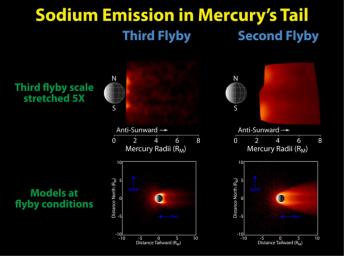Modeling the “Seasons” of Mercury’s Tail
Caption:
Comparisons of the neutral sodium observed during the second and third Mercury flybys to models are shown in this figure. The top left and right panels show the same observations as the
image released Tuesday
, but the color scale for the third flyby has been stretched to show the distribution of sodium more clearly. As in previous flybys, the distinct north and south enhancements in the emission that result from material being sputtered from the surface at high latitudes on the dayside are seen. The lower two panels show Monte Carlo models of the sodium abundance in Mercury's exosphere for conditions similar to those during the two flybys. These models illustrate that the "disappearance" of Mercury's neutral sodium tail is consistent with the change in conditions. Observations of the sodium exosphere and tail throughout Mercury's orbit during MESSENGER's orbital mission phase will enable such "seasonal" effects to be studied. Refinement of models similar to these will lead to an improved understanding of the source and loss processes and their variations among Mercury's different exospheric "seasons."
Date Acquired:
October 6, 2008, and September 29, 2009
Instrument:
Mercury Atmospheric and Surface Composition Spectrometer (MASCS)
Background Info:
These images are from MESSENGER, a NASA Discovery mission to conduct the first orbital study of the innermost planet, Mercury. For information regarding the use of images, see the MESSENGER
image use policy
.
Cataloging Keywords:
| Name |
Value |
Additional Values |
| Target |
Mercury |
|
| System |
|
|
| Target Type |
Planet |
|
| Mission |
MESSENGER |
|
| Instrument Host |
MESSENGER |
|
| Host Type |
Orbiter |
|
| Instrument |
Mercury Atmospheric and Surface Composition Spectrometer (MASCS) |
|
| Detector |
|
|
| Extra Keywords |
Atmosphere, Color |
| Acquisition Date |
|
| Release Date |
2009-11-05 |
| Date in Caption |
2008-10-06 |
2009-09-29 |
| Image Credit |
NASA/Johns Hopkins University Applied Physics Laboratory/Carnegie Institution of Washington |
| Source |
photojournal.jpl.nasa.gov/catalog/PIA12367 |
| Identifier |
PIA12367 |

 Planetary Data System
Planetary Data System
